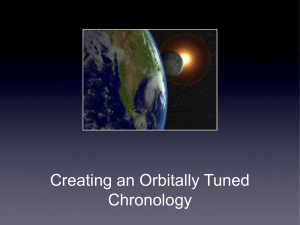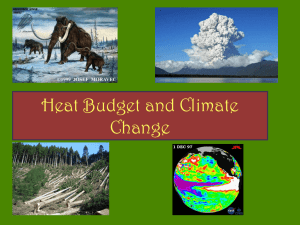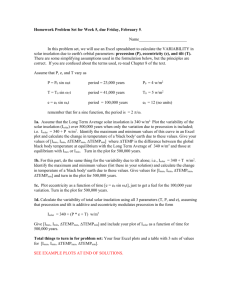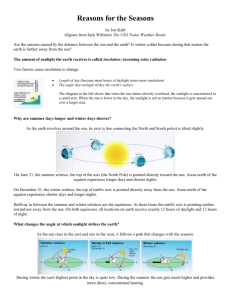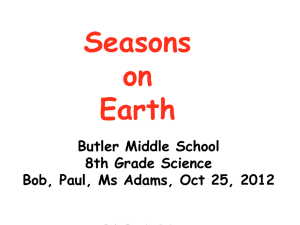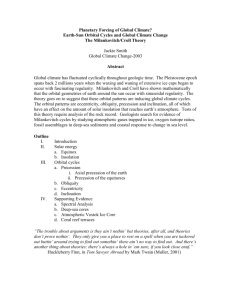Student Handout for Milankovitch Cycles
advertisement
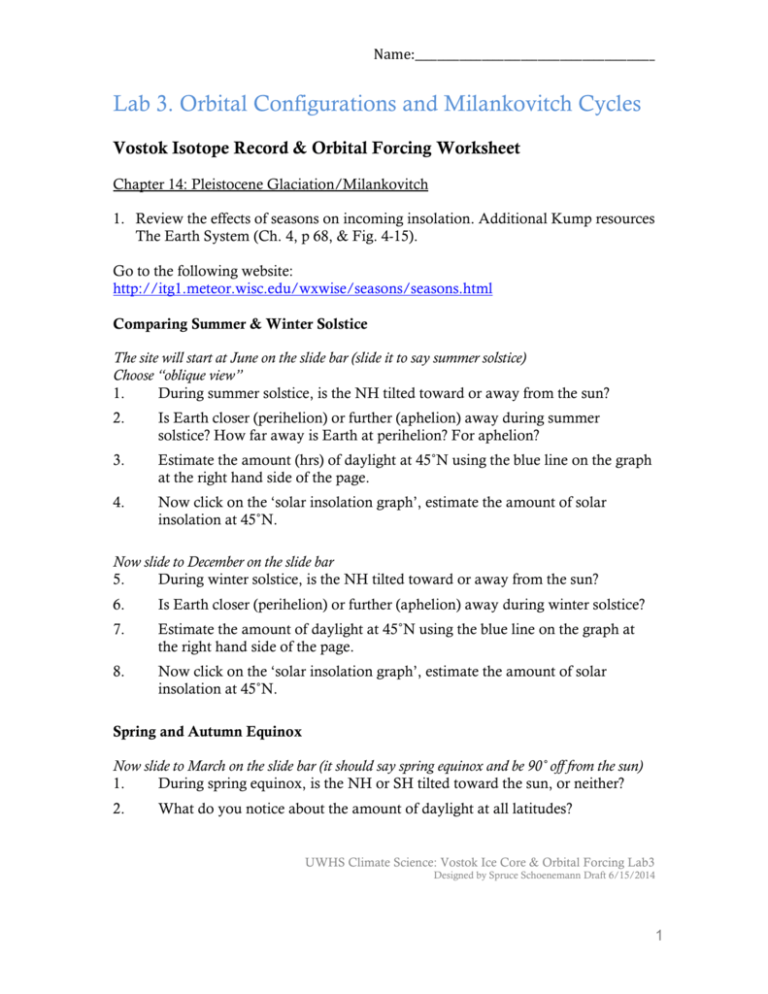
Name:___________________________________________ Lab 3. Orbital Configurations and Milankovitch Cycles Vostok Isotope Record & Orbital Forcing Worksheet Chapter 14: Pleistocene Glaciation/Milankovitch 1. Review the effects of seasons on incoming insolation. Additional Kump resources The Earth System (Ch. 4, p 68, & Fig. 4-15). Go to the following website: http://itg1.meteor.wisc.edu/wxwise/seasons/seasons.html Comparing Summer & Winter Solstice The site will start at June on the slide bar (slide it to say summer solstice) Choose “oblique view” 1. During summer solstice, is the NH tilted toward or away from the sun? 2. Is Earth closer (perihelion) or further (aphelion) away during summer solstice? How far away is Earth at perihelion? For aphelion? 3. Estimate the amount (hrs) of daylight at 45˚N using the blue line on the graph at the right hand side of the page. 4. Now click on the ‘solar insolation graph’, estimate the amount of solar insolation at 45˚N. Now slide to December on the slide bar 5. During winter solstice, is the NH tilted toward or away from the sun? 6. Is Earth closer (perihelion) or further (aphelion) away during winter solstice? 7. Estimate the amount of daylight at 45˚N using the blue line on the graph at the right hand side of the page. 8. Now click on the ‘solar insolation graph’, estimate the amount of solar insolation at 45˚N. Spring and Autumn Equinox Now slide to March on the slide bar (it should say spring equinox and be 90˚ off from the sun) 1. During spring equinox, is the NH or SH tilted toward the sun, or neither? 2. What do you notice about the amount of daylight at all latitudes? UWHS Climate Science: Vostok Ice Core & Orbital Forcing Lab3 Designed by Spruce Schoenemann Draft 6/15/2014 1 Name:___________________________________________ 3. Now click on the ‘solar insolation graph’, what do you notice about the distribution of incoming insolation? Why is there more insolation occurring at the equator than at the poles? 4. What is the primary cause for the seasons? Part 2. Examining the effects of orbital variations on incoming insolation and comparison with the Vostok Ice Core Record Go to the following website: http://itg1.meteor.wisc.edu/wxwise/climate/earthorbit.html Investigating Eccentricity -- For starters, at the bottom of the page, be sure to click Show Top View, click Orbit, and unlick Rotation. Now click on Eccentricity (a long wavy purple line is added) --To see how the eccentricity of the earth’s orbit varies through time, slide the grey slider arrow back and forward in time. 1. What part of earth’s orbital parameters is changing? 2. When the eccentricity is low (toward left), is the earth’s orbit more circular or elliptical? 3. How well do the variations in Vostok Temperature (from δD) track the eccentricity curve? 4. In your own words, describe eccentricity? 5. Estimate the frequency on one eccentricity cycle (peak-to-peak) using the time bar on the slider. Investigating Precession --Reload page. Now click Precession. Again, slide the grey slider arrow back and forward in time. 6. Observe the orientation of earth’s axis. What is happening to where it points? -Click on Faster Orbit. Allow earth to orbit until it is all the way to the right (Perihelion). Unclick Faster Orbit. Click to Show Side View. Use Grey Slider to return to Now UWHS Climate Science: Vostok Ice Core & Orbital Forcing Lab3 Designed by Spruce Schoenemann Draft 6/15/2014 2 Name:___________________________________________ 7. When the precession is at a complete minimum (all-the-way left on pink graph), which way is the earth’s axis pointed in the NH (toward, away, or upright from the sun)? 8. What about when precession is at a maximum (all-the-way right on graph)? 9. When precession is very low, is the NH experiencing summer or winter solstice each time? 10. Estimate the frequency of one precession cycle (peak-to-peak). 11. From the periods in the Vostok Ice Core record where temperatures are the warmest (~128k, ~241k), which precession configuration provides the warmest temperatures? (for example, aphelion & NH tilted away from the sun) 12. In your own words, describe what precession does? Investigating Obliquity (Tilt) -Reload page. Now click Tilt. Allow earth to orbit until it is all the way to the right (Perihelion) and says Winter Solstice. Click to Show Side View. Again, slide the grey slider arrow back and forward in time. 13. Observe the movement of earth’s axis. What is happening to it? 14. When the obliquity is at a complete minimum (all-the-way left), is the tilt of the earth’s axis increased or decreased? -Follow the same instructions as above, but allow earth to orbit until it reaches (Aphelion) and says Summer Solstice. 15. When the obliquity is at a complete maximum (all-the-way right), is the angle of tilt in the NH increased or decreased? 16. When earth is at Aphelion, if the angle of tilt is decreased from 23.5˚ to 22.5˚, do you think the NH summer is going to get cooler or warmer? 17. Estimate the frequency of one obliquity cycle (peak-to-peak). Investigating All Three Orbital Parameters (Milankovitch Cycles) UWHS Climate Science: Vostok Ice Core & Orbital Forcing Lab3 Designed by Spruce Schoenemann Draft 6/15/2014 3 Name:___________________________________________ -Reload page. Now click all three parameters: Eccentricity, Precession, & Tilt. Allow earth to orbit until it is all the way to the right (Perihelion). Click to Show Side View. Again, slide the grey slider arrow back and forward in time. 18. Slide back in time to ~141k to the previous glacial maximum. What are the ideal orbital configurations to maintain a cold glacial period? Why? Draw a diagram. 19. Now slide the grey arrow forward in time to the prior interglacial maximum (~127k ). What are the ideal orbital configurations to cause a warm interglacial period? Why? Sketch a diagram to explain your answer. 20. What are the primary orbital configurations, and what are the periodicities of each. Sketch a diagram of each configuration; be sure to include annotations (labels!) to describe the ranges of variability. UWHS Climate Science: Vostok Ice Core & Orbital Forcing Lab3 Designed by Spruce Schoenemann Draft 6/15/2014 4 Name:___________________________________________ UWHS Climate Science: Vostok Ice Core & Orbital Forcing Lab3 Designed by Spruce Schoenemann Draft 6/15/2014 5
